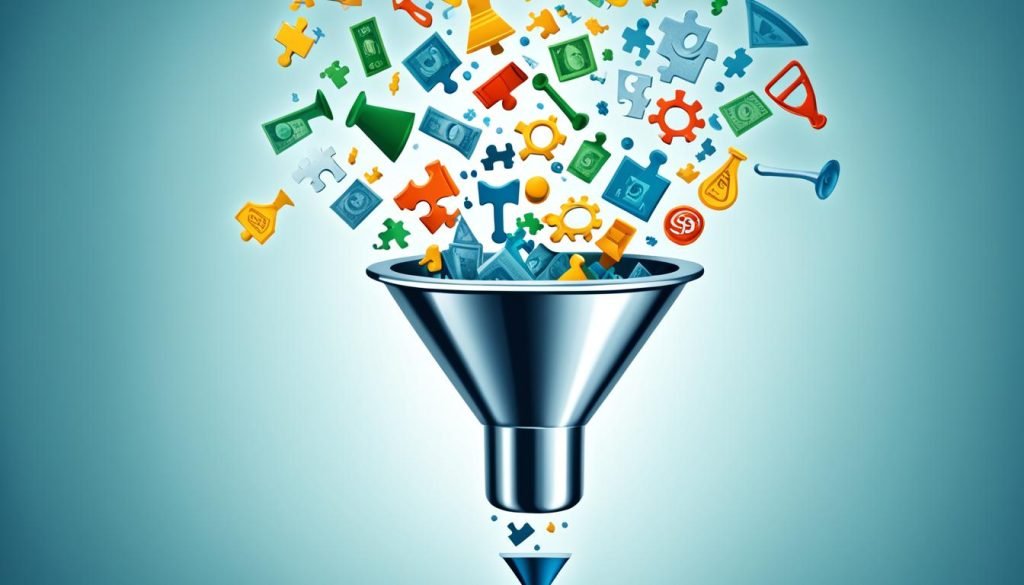Are you struggling to convert leads into paying customers? Is your sales process not delivering the desired results? It’s time to unlock the full potential of your business by optimizing your sales funnel.
A sales funnel is a powerful framework that guides prospects through each stage of the customer journey, from awareness to action. By understanding and optimizing this process, you can turn leads into conversions and boost your revenue.
In this article, we will explore the key components of sales funnel optimization and provide you with actionable strategies to supercharge your sales process. Get ready to revolutionize your approach and achieve remarkable success!
Key Takeaways:
- Sales funnel optimization is crucial for converting leads into customers and increasing revenue.
- A well-optimized sales funnel guides prospects through the stages of awareness, interest, decision, and action.
- By implementing targeted strategies such as lead qualification, personalized content, and compelling offers, you can optimize your sales funnel for success.
- Lead scoring and tracking tools help prioritize and nurture leads effectively.
- Continuously monitoring and testing your strategies, utilizing social proof and automation, and analyzing data are essential for successful sales funnel optimization.
Why Sales Funnels Are Important for Business Success
Sales funnels play a vital role in the success of your business. Acting as a roadmap for your customer journey, sales funnels help you understand and engage with your potential customers at each stage of their buying process. By optimizing the activities within each stage, you can identify and improve weak points in the funnel, ultimately leading to increased conversions, revenue, and customer loyalty.
Every marketing activity you undertake should be aligned with a specific stage of the sales funnel. Whether it’s creating awareness, generating interest, driving the decision-making process, or encouraging action, sales funnels provide a clear framework to guide your efforts. This strategic approach ensures that you are targeting the right audience with the right message at the right time, maximizing your chances of success.
Optimizing your sales funnel involves a deep understanding of your customer journey. By analyzing data and gaining insights into customer behavior, preferences, and pain points, you can tailor your marketing activities to meet their specific needs. This level of personalization helps build trust, establish relationships, and create meaningful connections with your audience.
“A well-optimized sales funnel can lead to increased conversions, revenue, and customer loyalty.”
The Benefits of Sales Funnel Optimization
Optimizing your sales funnel yields several significant benefits for your business:
- Increased Conversions: By addressing customer pain points and providing tailored solutions at each stage of the funnel, you can increase the likelihood of conversions. A well-optimized funnel guides potential customers through their decision-making process, removing obstacles and nurturing them towards the desired action.
- Higher Revenue: When your sales funnel is efficient and effective, more prospects are converted into paying customers. This results in higher revenue generation for your business.
- Improved Customer Loyalty: By personalizing your marketing efforts and providing exceptional experiences throughout the customer journey, you can foster loyalty and turn customers into brand advocates. Satisfied customers are more likely to make repeat purchases and refer your business to others.
Optimizing your sales funnel is an ongoing process. It requires continuous monitoring, testing, and refinement to ensure that it remains aligned with the ever-changing needs of your target audience. By leveraging data analytics and implementing proven strategies, you can continually improve your sales funnel and drive consistent business growth.
The 4 Stages of a Sales Funnel
A sales funnel is a strategic framework that guides potential customers through different stages of the buying process. Understanding the four stages of a sales funnel – awareness, interest, decision, and action – is crucial for optimizing your sales process and increasing conversions.
In the awareness stage, prospective customers become acquainted with your brand and the products or services you offer. This is the top of the funnel, where you aim to generate awareness and attract a broad audience. It is essential to create compelling and engaging content that grabs their attention and showcases the value of your offerings.
In the interest stage, potential customers actively seek solutions to their needs and show interest in what you have to offer. They may conduct research, compare options, and engage with your content. This is an opportunity to provide valuable information, address their pain points, and nurture their interest in your brand.
In the decision stage, prospects weigh the benefits, features, and pricing of your offerings against those of your competitors. This is the middle of the funnel, where you need to build trust and establish your brand as a preferred choice. Offering testimonials, case studies, and product demonstrations can help prospects make an informed decision in your favor.
In the action stage, prospects have made their decision and take the desired action, becoming customers. This is the bottom of the funnel, where you facilitate a smooth buying process and provide exceptional customer service. It is crucial to have clear calls-to-action and a seamless purchasing experience to encourage prospects to take that final step.
Understanding and optimizing each stage of the sales funnel is vital for guiding potential customers towards making a purchase. By tailoring your marketing strategies to address the needs and motivations of your target audience at every stage, you can effectively move them through the funnel and increase conversions.
| Sales Funnel Stage | Description |
|---|---|
| Stage 1: Awareness | Prospects become acquainted with your brand and offerings. Generate awareness through engaging content and targeted marketing strategies. |
| Stage 2: Interest | Prospects actively seek solutions and show interest in your offerings. Nurture their interest through valuable information and personalized interactions. |
| Stage 3: Decision | Prospects compare your offerings with competitors and make a decision. Establish trust and highlight the unique value your brand provides. |
| Stage 4: Action | Prospects become customers by taking the desired action. Provide clear calls-to-action and a streamlined buying process to facilitate conversions. |
How to Optimize Your Sales Funnel: 9 Tactics to Consider
To optimize your sales funnel and maximize conversions, consider implementing the following strategies:
- Identify and segment your target audience through market research: Determine who your ideal customers are and create detailed buyer personas based on demographic, psychographic, and behavioral factors. This will allow you to tailor your marketing messages and strategies to specific audience segments.
- Create lead magnets to capture potential customers’ email addresses: Offer valuable incentives, such as e-books, case studies, or exclusive discounts, in exchange for prospects’ contact information. This will help you build an email list of engaged leads that you can nurture over time.
- Personalize communication to better resonate with your audience: Use marketing automation tools and customer relationship management (CRM) systems to send personalized emails, targeted advertisements, and tailored content based on each prospect’s preferences and past interactions.
- Utilize social media platforms to connect with your target audience: Identify the social networks where your target audience spends the most time and actively engage with them. Share valuable content, participate in industry discussions, and respond to comments and inquiries promptly.
- Build an online community to engage with potential customers: Create a forum, Facebook group, or online community where your target audience can interact with each other and discuss topics related to your brand or industry. This will foster a sense of belonging and loyalty among potential customers.
- Implement effective follow-up strategies, such as email remarketing: Set up automated email sequences to follow up with leads who have shown interest but haven’t made a purchase yet. Remind them of the benefits of your product or service and address any concerns or objections they may have.
- Master persuasive copywriting techniques to captivate potential customers: Craft compelling and persuasive copy that speaks directly to your target audience’s pain points, desires, and aspirations. Use storytelling, social proof, and emotional language to create a compelling narrative that motivates action.
- Use compelling calls to action to motivate your audience to take action: Clearly communicate the next steps you want your audience to take, whether it’s signing up for a free trial, scheduling a consultation, or making a purchase. Use action-oriented language and design eye-catching buttons or links to encourage click-throughs.
- Leverage social proof to influence buying decisions: Showcase positive customer reviews, testimonials, case studies, and endorsements to build trust and credibility. Social proof creates a sense of confidence and reduces perceived risks, making prospects more likely to convert.
By implementing these sales funnel optimization strategies, you can enhance the customer journey, increase conversions, and drive revenue for your business.
| Sales Funnel Optimization Tactics | Description |
|---|---|
| Identify and segment your target audience through market research | Determine your ideal customers’ characteristics and divide them into distinct segments for targeted marketing. |
| Create lead magnets to capture potential customers’ email addresses | Offer valuable incentives in exchange for contact information to build an email list of engaged leads. |
| Personalize communication to better resonate with your audience | Use automation and CRM systems to send personalized messages and content tailored to each prospect. |
| Utilize social media platforms to connect with your target audience | Engage with prospects on social networks, share valuable content, and respond to comments and inquiries. |
| Build an online community to engage with potential customers | Create a forum or online group for your audience to interact with each other and your brand. |
| Implement effective follow-up strategies, such as email remarketing | Set up automated email sequences to follow up with leads and address any concerns or objections. |
| Master persuasive copywriting techniques to captivate potential customers | Create compelling copy that speaks to your audience’s pain points, desires, and aspirations. |
| Use compelling calls to action to motivate your audience to take action | Clearly communicate the next steps you want your audience to take with persuasive and action-oriented language. |
| Leverage social proof to influence buying decisions | Showcase positive reviews, testimonials, and endorsements to build trust and credibility. |
Setting Specific Lead Qualification Criteria
To optimize your sales funnel and increase your chances of converting leads into customers, it is crucial to set specific lead qualification criteria. By identifying and understanding your target audience’s needs and pain points, you can create valuable content that captures their interest and contact information. But how do you determine which leads are most likely to convert?
Setting lead qualification criteria allows you to segment your leads based on various factors such as demographic information, purchase intent, budget considerations, and engagement level. This helps you prioritize your efforts and focus on those leads that are most likely to become paying customers.
Here are some key elements to consider when setting lead qualification criteria:
- Demographic Information: Consider factors such as age, gender, location, industry, and job role to better understand your target audience and their specific needs.
- Purchase Intent: Evaluate how interested the lead is in your product or service. Are they actively seeking a solution or just browsing?
- Budget Considerations: Determine whether the lead has the financial capacity to make a purchase. Consider factors such as their budget, spending power, and financial goals.
- Engagement Level: Analyze the level of engagement the lead has shown with your brand. Have they shown interest in specific products, attended webinars, or subscribed to your newsletter?
By considering these factors and setting specific lead qualification criteria, you can effectively prioritize your lead nurturing efforts and allocate your resources wisely. It allows you to focus on leads that have a higher likelihood of conversion, ultimately increasing your sales efficiency and maximizing your return on investment.
“Setting specific lead qualification criteria ensures that you are targeting the right audience with the right message at the right time. It helps you prioritize your resources and focus on leads with the highest potential for conversion.”

By aligning your lead qualification criteria with your overall sales and marketing goals, you can streamline your lead management process and improve the overall efficiency of your sales funnel. Remember, not all leads are created equal, and by qualifying them effectively, you can increase your chances of success.
Developing Targeted Lead Nurturing Campaigns
Targeted lead nurturing campaigns play a crucial role in guiding leads through the sales funnel. By creating personalized and relevant content that addresses their specific needs and interests, businesses can build trust, foster relationships, and ultimately increase the chances of conversion.
Lead nurturing involves consistently engaging with and educating leads at each stage of the buying process, ensuring they remain interested and informed about your products or services. This can be achieved through various channels, including:
- Email marketing: sending targeted and automated emails that provide valuable content and relevant offers.
- Social media platforms: leveraging social media channels to share informative and engaging content, interact with leads, and build brand awareness.
- Webinars: hosting webinars to educate leads, address their pain points, and showcase your products or services as solutions.
- Podcasts: producing podcasts that offer valuable insights, industry trends, and interviews with experts to establish thought leadership and keep leads engaged.
By utilizing these lead nurturing tactics, businesses can stay top-of-mind with their leads, nurture relationships, and move them closer to making a purchase decision.
“Lead nurturing is all about building trust with your leads. By consistently delivering personalized and valuable content that resonates with their needs, you can establish yourself as a trusted advisor and make the sales process smoother.” – Amanda Williams, Marketing Manager at XYZ Company
Example Lead Nurturing Campaign
To illustrate the effectiveness and impact of targeted lead nurturing campaigns, let’s consider an example in the software industry:
| Stage | Content Type |
|---|---|
| Awareness | Blog article: “The Benefits of Cloud-Based Software” |
| Interest | Whitepaper: “How Cloud-Based Software Improves Efficiency” |
| Decision | Comparison infographic: “Cloud-Based Software vs. On-Premise Solutions” |
| Action | Free trial offer with personalized onboarding |
In this example, the lead nurturing campaign delivers content that aligns with the buyer’s journey. It starts by raising awareness through a blog article, progresses to nurturing interest with a whitepaper, helps the buyer make an informed decision through a comparison infographic, and finally encourages action through a personalized free trial offer.
By tailoring content to address the buyer’s specific stage in the sales funnel and providing personalized experiences, businesses can effectively nurture leads, drive engagement, and ultimately increase conversions.
Lead nurturing campaigns are a powerful tool in a business’s sales and marketing arsenal. By creating personalized content and delivering it through various channels, businesses can establish meaningful connections with leads and guide them towards making a purchase decision.
Creating Compelling Content and Offers
Compelling content and offers play a crucial role in optimizing your sales funnel. By leveraging storytelling techniques, customer-centric language, and social proof, you can create engaging and persuasive content that resonates with your target audience. Additionally, designing attractive offers and tailoring them to align with your audience’s needs and preferences helps create a sense of urgency and encourages prompt decision-making.
When crafting high-quality content, storytelling can captivate your audience and evoke emotions that drive them to take action. By weaving narratives that highlight the benefits of your products or services, you can demonstrate their value and address your customers’ pain points effectively.
“Stories are a powerful tool in marketing. They help transport your audience to a world where their problems are solved and their desires are fulfilled.”
Using customer-centric language is another effective way to engage your audience. By speaking directly to their needs, desires, and aspirations, you can establish a connection and build trust. Addressing the unique challenges your audience faces and showcasing how your offerings provide solutions will resonate with them on a deeper level.
Social proof is a powerful persuasion technique that can enhance the credibility of your content and offers. Consider including testimonials, reviews, case studies, or statistical data to demonstrate the success and satisfaction of your previous customers. This creates trust, reduces skepticism, and encourages potential customers to make confident purchase decisions.
When it comes to designing compelling offers, it’s important to consider your audience’s needs and preferences. Tailoring your offers to specific segments of your target audience ensures relevance and increases the chances of conversion.
Providing exclusive deals, limited-time promotions, or bundled packages creates a sense of urgency and scarcity, motivating your audience to take immediate action. Offering free trials, demos, or samples allows potential customers to experience the value of your products or services firsthand, increasing their confidence in making a purchase.
In summary, creating high-quality content and compelling offers is essential for optimizing your sales funnel. By utilizing storytelling techniques, customer-centric language, and social proof, you can captivate your audience and persuade them to take action. Tailoring your offers to align with your audience’s needs and preferences further enhances their effectiveness. Remember, a well-crafted content strategy and enticing offers can significantly increase your conversions and drive business success.
Implementing Lead Scoring and Tracking
Implementing lead scoring and tracking systems is essential for effectively managing and prioritizing your leads. Lead scoring involves assigning a numeric value to each lead based on their level of engagement with your marketing efforts and their fit with your ideal customer profile. This allows you to focus your resources on leads that are more likely to convert, improving the efficiency of your sales process.
To implement lead scoring, you can utilize customer relationship management (CRM) systems and automation tools. These tools provide you with the ability to track and analyze prospect activities, such as email opens, website visits, and social media engagements. By setting up predefined rules within your CRM, you can automatically assign scores to leads based on their actions and attributes.
By using lead scoring, you can prioritize your follow-up efforts and tailor your communication based on each lead’s engagement level. Leads with higher scores can be fast-tracked for immediate attention and personalized outreach, while leads with lower scores can be nurtured with relevant content to further qualify them.
“Lead scoring enables us to focus our efforts on leads that are most likely to convert, allowing us to optimize our sales process and drive better results.”
Lead scoring also allows you to identify any gaps or weaknesses in your marketing and sales funnel. By analyzing the scores of your leads at each stage of the funnel, you can determine which areas need improvement and optimize your strategies accordingly.
Furthermore, lead scoring can help align your marketing and sales teams. By implementing a shared lead scoring system, both teams can have visibility into the lead’s engagement and prioritize their efforts accordingly. This collaboration ensures that leads are effectively transitioned from marketing to sales, reducing the chances of leads slipping through the cracks.
Benefits of Lead Scoring and Tracking:
- Efficiently prioritize and allocate resources to high-quality leads
- Improve lead nurturing and conversion rates
- Identify gaps or weaknesses in your marketing and sales funnel
- Align marketing and sales teams for effective lead management
- Enhance overall customer experience and satisfaction
Implementing lead scoring and tracking systems within your CRM can be a game-changer for your sales and marketing efforts. By leveraging data-driven insights and automation, you can maximize the effectiveness of your lead management strategies and drive better results.
Conclusion

Sales funnel optimization plays a crucial role in transforming leads into conversions and maximizing revenue. By understanding the stages of a sales funnel and implementing effective strategies, businesses can optimize their sales process for success.
To begin with, it is essential to identify and segment your target audience. Conduct market research to gain insights into their needs, preferences, and pain points. This information will help you create tailored content and offers that resonate with your audience and increase the chances of conversion.
In addition, implementing lead nurturing and lead scoring techniques can significantly impact your sales funnel. By developing targeted campaigns and personalized content, you can build trust, foster relationships, and guide leads through the funnel towards making a purchase. Utilizing CRM systems and automation tools allows for efficient lead scoring and tracking, enabling you to prioritize leads and trigger personalized interactions based on predefined rules.
Continuous monitoring, testing, and analysis are vital for sales funnel optimization. By monitoring the performance of your strategies, testing different approaches, and analyzing data through analytics tools, you can identify areas for improvement and make data-driven decisions to optimize your sales funnel further.







